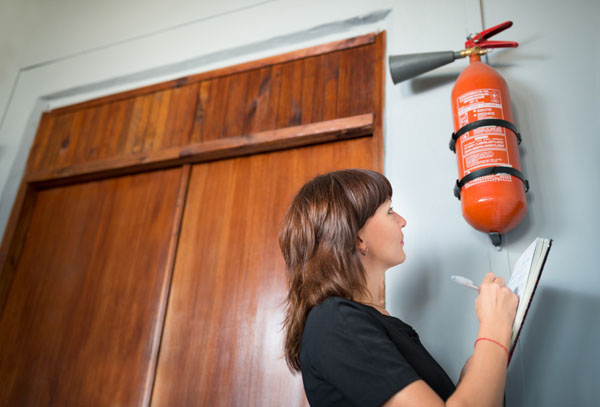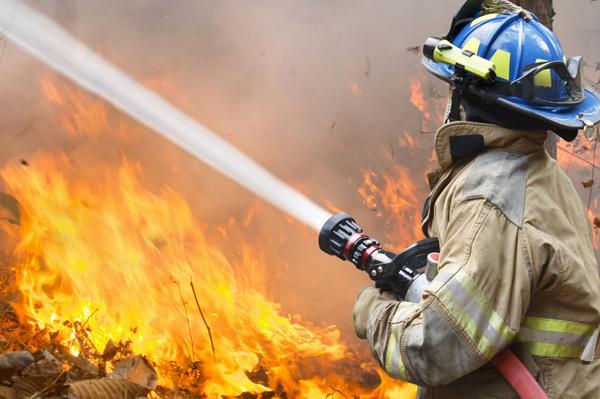When entering the firefighting industry, in most countries, there are a variety of job types from which career-seekers can choose, ranging from fire inspectors to firefighting engineers. No matter the type of career, however, EMCARE’s firefighting course options will help you on your way to pursuing your dream firefighting job. In just a few minutes of reading, find out about some of the most common firefighting jobs, as well as how our firefighting course will help you to prepare for them.
1. Wildland firefighter
This firefighting career requires firefighters to focus on stopping wildfires in wilderness areas – many of which burn frequently during dry seasons. Their duties involve responding to emergency calls, rescuing people, maintaining tools such as chainsaws and utilising them to cut through trees should the need arise. These firefighters are most busy during summer, the season during which most areas experience wildfires. It is no secret that around the world, wildfires are becoming hotter and larger, becoming more similar to high profile incidents that occur in places like California and Australia.
In South Africa, we have seen the devastation caused by wildfires in areas such as Knysna, George, Cape Town and Betty’s Bay. Some say that the difference between wilderness firefighters and “normal” firefighters is the unique combination of experiences, physical fitness and skillsets that a worker has that allows them to operate for longer in more challenging conditions. Those who have spent years in the wildland firefighting industry are familiar with using high-tech tools, kitted-out vehicles – like helicopters – to get into difficultly accessed areas. Oftentimes, there is no other solution than a difficult hike to access the flames of the wildfire.
In many cases, these firefighters must remain self-sufficient for up to 2 days during deployment, spending days and nights high up on mountains or deep in forests – alone in the dark. These highly experienced firefighters work in skilled teams, including the initial attack crew that engages with open flames, or alternatively being part of other crews that help to “mop” up the situation behind the front lines. In this type of firefighting career, there is no substitute for experience. This is why even after participating in a firefighting course, there are usually a number of specialised follow-up programs or apprenticeships that are required in order to become an appealing candidate.
Within these programs, you will learn all about the different wildfire suppression tactics, as well as the different categories of wildland firefighting that exist. If you are an aspiring firefighter with a love for wildlife and the wilderness, this may be the perfect calling for you. As briefly mentioned, there are a number of different crew types in this type of occupation, such as:
- Hotshot crews
These crews consist of around 20, multi skilled and experienced professional firefighters who specialise in extended wildfire suppression tactics. They are usually called upon to work in more rugged terrain, and manage the most challenging areas of the blaze. The personal safety of these firefighters depends largely on their maintaining a peak physical fitness. This category of wildland firefighting is incredibly competitive, and additional training after a basic firefighting course is always required from relevant wildfire institutions once you have mastered the basics.
- Helitack crews
This crew usually ranges from between 7 to 24 members who are specialised in operating helicopters in the suppression of wildfires. This crew is often the first to respond and arrive on scene, and are often relied upon to transport support crew and cargo, as well as fire suppression efforts. In some cases, helicopters operated by helitack crews make use of fixed tanks used to dump water or other fire retardants on wildfires to support ground crews. Those who wish to become a member of a helitack crew will require an additional firefighting course focused on utilising rappel systems from a hovering helicopter. This is because in many cases, helicopters cannot land and safely deposit crew onto the ground. - Smokejumpers
These wildland firefighters specialise in jumping out of airplanes and parachuting down to areas ravaged by emerging or ongoing wildfires. They are tasked with providing a rapid response, in situations that are highly time-sensitive, and other means of travel would just take too long. Like helitack crews, smokejumpers aid in fire suppression as well as provide hazardous fuels reduction support when necessary. These crews usually consist of between 8 to 10 members – depending on the size of the aircraft. In order to become a smokejumper, years of experience is essential, usually as part of a helitack, hotshot or fuel crew.
2. Airport firefighter
Airport firefighters specialise in dealing with airplane fires on runways, as well as other airport emergencies. They make use of certain equipment such as chemical agents and firefighting foams more often than other firefighters, due to the dangers of mixing oil and water or even electrical fires. These firefighters operate airport fire tenders in order to speedily get to the scene of the fire as well as transport equipment. Many airports employ their own firefighting crews on the premises, in order to ensure excellent response times and allow for quick passenger evacuation during a fire emergency. In this type of firefighting career, there is a large emphasis on airplane knowledge and speed.

3. Fire investigator
Fire investigators enter the scene after a fire has been extinguished, in order to determine the cause of the blaze. During the course of the investigation, they find and analyse evidence to establish whether the fire was the cause of an accident, negligence or arson. In the case of the latter, they will seek out arson suspects. This unconventional firefighting career requires an in-depth knowledge of fire science, the scientific method and in some cases – police training. In some cases, fire investigators are part of a police force and not a firefighting institution, but it is quite common for these individuals to take part in a firefighting course and help to extinguish the blaze before the investigation begins.
It takes a special type of person to succeed as a fire investigator. One needs to have an analytical knack for solving problems, as well as have a background in firefighting and engineering. Those who become fire investigators often begin their careers as standard firefighters and work their way up to fire detective work. A normal work day for someone in this position could start with a visit to a destroyed pile of smoking rubble, whereupon a series of questions must be asked:
- Was foul play involved?
- How did the fire begin?
- Where did the fire begin?
- How did the building’s inner furnishings or outer design contribute to the fire’s spread and progression?

A bit later on in the investigation, fire investigators may be called to testify at preliminary hearings. It is often the case that the city, or individuals, may wish to press charges against manufacturing companies and businesses that burnt down due to a failure to adhere to prevention codes. Should there be a loss of life involved, the significance of these cases cannot be understated.
4. Volunteer firefighter
Becoming a volunteer firefighter entails providing part-time support to your local fire stations. As a volunteer firefighter, you will remain on-call to respond to local fire emergencies. As the name suggests, this type of job is mainly volunteer work – although some institutions do offer basic salaries. Despite this, volunteer firefighting is highly important, especially in areas where there are not enough salaried firefighters to deal with the number of emergencies. Volunteer firefighters typically drive fire trucks, administer first aid and physically fight fires with the necessary tools. Oftentimes, volunteer firefighters hold other job positions and help to fight fires only when they are available.
5. Fire inspector
Fire inspectors are charged with ensuring that buildings are maintaining the standard fire safety code requirements. Should an inspector find a problem, such as flammable materials located in dangerous places or blocked evacuation routes, they are able to enforce fire codes in order to promote occupant and building safety. Inspectors practice fire prevention in their own way – by working directly with the public and educating them on how to prevent fires before they take place.
Unlike many of the firefighting jobs on this list, inspectors do not need to take part in an extended firefighting course to practice physical firefighting at any stage in their career. Despite this, many fire inspectors do come from firefighting backgrounds. Some of them choose to operate as standard firefighters simultaneously.

6. Firefighter engineer
The work of firefighter engineers mainly has to do with fire engines and trucks that are used to transport cargo, equipment and firefighters to the scene of a blaze. They are often responsible for setting up equipment like water hoses and ladders for other firefighters to use when battling a fire. These individuals specialise in repairing and maintaining the fire department vehicles and tools. Firefighter engineers must also undergo special training that enables them to confidently drive in dangerous conditions. Should you have a knack for mechanical knowledge and are willing to take part in a firefighting course or two, this may be the perfect job for you.
7. Firefighter EMT
Becoming a firefighter EMT (emergency medical technician) will require you to respond to both fire and medical emergencies. It is common for firefighters to possess EMT certification so that they are able to provide medical services to both animals and people on the scene of a fire emergency. Like standard firefighters, firefighter EMTs extinguish fires, but differ in the way that they can also provide emergency medical care and can transport injured people in ambulances to the hospital. In many fire departments, all firefighters are required to take part in EMT training and achieve certification.
8. Firefighter paramedic
Going a step further than the firefighter EMT, firefighter paramedics undergo advanced medical training on top of their firefighting course. They are equipped to fight fires as well as respond to life-threatening emergencies with their vast skill set. In order to be considered for this type of job, you will need to have amassed significant field experience as well as pass a series of health checks. Firefighter paramedics are qualified to diagnose and enact medical procedures on the scene, as well as create and file incident reports that are sent with the patient to hospitals after the administer care.

Taking part in an EMCARE firefighting course to prepare you for a fulfilling career
As you now know, there are numerous different types of firefighting careers from which to choose. The most important thing to remember is that you must commit to solid and in-depth training should you wish to prepare yourself for the career as well as make yourself an appealing candidate. At EMCARE, you can find the perfect firefighting course that will help you on your way to choosing the best firefighting career for you.















